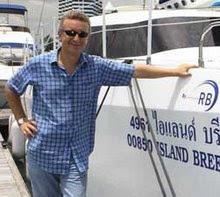
In the early days of my company, I had so few workers, it didn't really matter where they parked. Most had – still have – motorbikes rather than cars and they parked them in the yard itself, often right under the boat they were working on. In my first yard in Pattaya, which was also my first house, even I had to park on the street because my car port had been turned into a boat shed and saw mill.
Things are a little different now. At the Jomtien yard, which is actually two yards in separate, large, hangar-like, concrete-floored, corrugated metal sheds, we have had to create a formalised parking space outside, not just for workers and management but also the increasing number of current and potential clients who visit. Right now, one of these yards alone employs maybe 30 people aboard two power cats, one 45-foot long, the other 50-foot, as well as a 60-foot traditional motor yacht, and a Tiki 38 sailing cat, all in advanced stages of construction.
Below: Workers' motorbikes parked outside the long, concrete wall of RB's yard, on land reclaimed from jungle near Jomtien, south of Pattaya.
Things are a little different now. At the Jomtien yard, which is actually two yards in separate, large, hangar-like, concrete-floored, corrugated metal sheds, we have had to create a formalised parking space outside, not just for workers and management but also the increasing number of current and potential clients who visit. Right now, one of these yards alone employs maybe 30 people aboard two power cats, one 45-foot long, the other 50-foot, as well as a 60-foot traditional motor yacht, and a Tiki 38 sailing cat, all in advanced stages of construction.
Below: Workers' motorbikes parked outside the long, concrete wall of RB's yard, on land reclaimed from jungle near Jomtien, south of Pattaya.

No comments:
Post a Comment
Note: Only a member of this blog may post a comment.